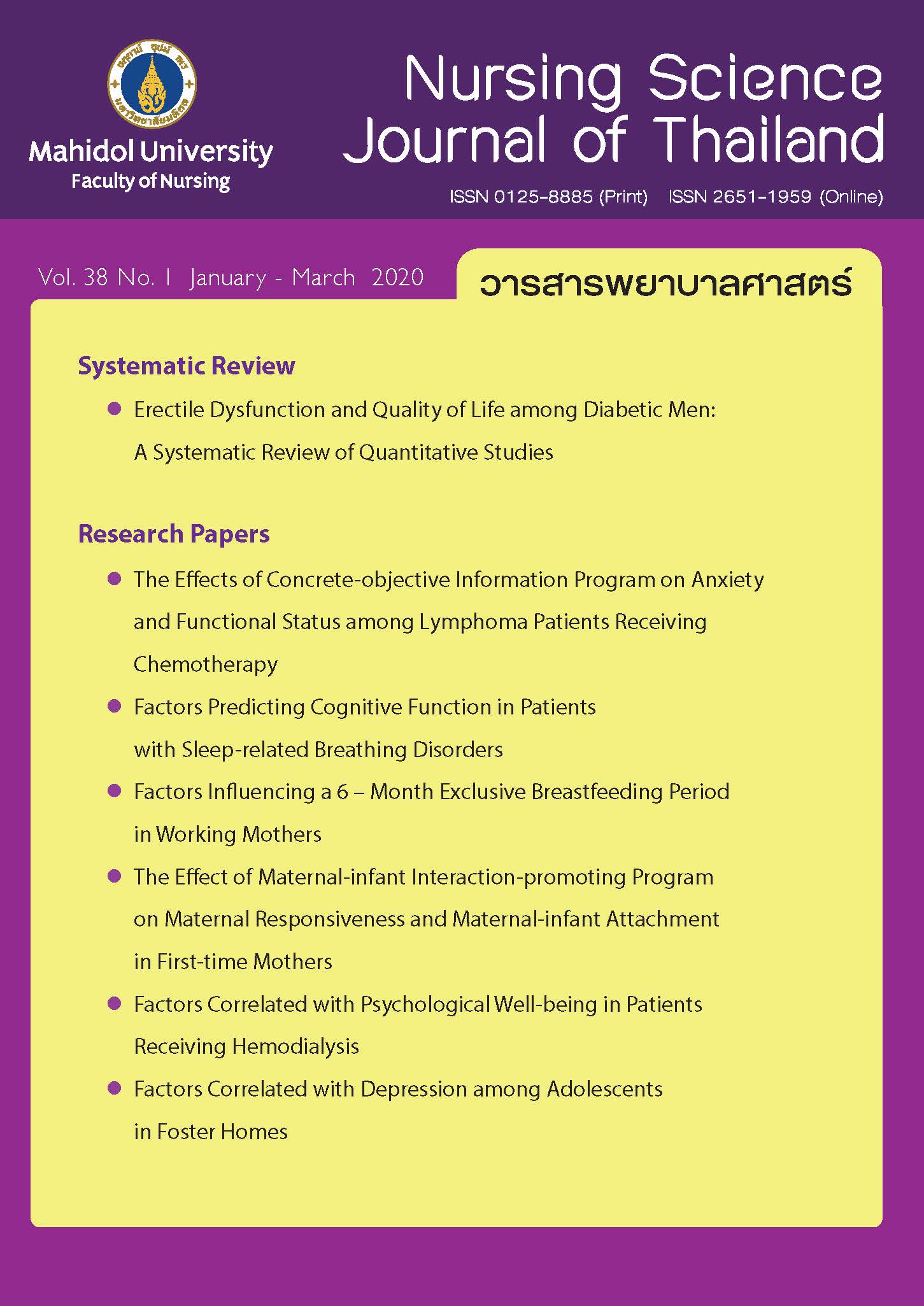ปัจจัยทำนายการรู้คิดในผู้ป่วยที่มีภาวะหายใจผิดปกติขณะหลับ
Main Article Content
บทคัดย่อ
วัตถุประสงค์: เพื่อศึกษาอำนาจการทำนายของ ระดับความรุนแรงของภาวะหายใจผิดปกติขณะหลับ ดัชนีมวลกาย ระดับแอลบูมินในเลือด และระดับของกิจกรรมทางกายต่อการรู้คิดในผู้ป่วยที่มีภาวะหายใจผิดปกติขณะหลับ
รูปแบบการวิจัย: การศึกษาความสัมพันธ์เชิงทำนาย
วิธีดำเนินการวิจัย: กลุ่มตัวอย่างเป็นผู้ป่วยที่มีภาวะหายใจผิดปกติขณะหลับจำนวน 140 คนที่มารับบริการที่ห้องตรวจโสต ศอ นาสิก คณะแพทยศาสตร์วชิรพยาบาล โดยกลุ่มตัวอย่างต้องมีอายุ 18 ปีขึ้นไป และมีคะแนนทดสอบระดับความง่วงนอนเอ็บเวิร์ธมากกว่าหรือเท่ากับ 10 เก็บข้อมูลโดยใช้แบบบันทึกข้อมูล แบบทดสอบระดับความง่วงนอนจากเอ็บเวิร์ธภาษาไทยฉบับปรับปรุง แบบประเมินขนาดของกิจกรรมทางกาย และแบบประเมินสภาพสมอง MMSE-Thai 2002 วิเคราะห์ข้อมูลด้วยสถิติเชิงพรรณนา และสถิติถดถอยพหุโลจิสติก
ผลการวิจัย: ผู้ป่วยที่มีภาวะหายใจผิดปกติขณะหลับที่มีระดับแอลบูมินในเลือดต่ำกว่าเกณฑ์ปกติ สามารถทำนายโอกาสเกิดภาวะพร่องการรู้คิด (AOR = 11.87, 95%CI = 2.91, 48.35, p < .001) และผู้ป่วยที่มีภาวะหายใจผิดปกติขณะหลับที่มีระดับกิจกรรมทางกายที่ไม่เพียงพอ สามารถทำนายโอกาสเกิดภาวะพร่องการรู้คิด (AOR = 63.84, 95%CI = 16.76, 243.16, p < .001) ซึ่งตัวแปรทั้งสองร่วมกันทำนายภาวะพร่องการรู้คิดได้ร้อยละ 66.8 (Negelkerke R2 = .668)
สรุปและข้อเสนอแนะ: ผลการวิจัยพบว่า ระดับแอลบูมินที่ต่ำกว่าเกณฑ์และการมีกิจกรรมทางกายที่ไม่เพียงพอร่วมทำนายการเกิดภาวะบกพร่องทางการรู้คิดในผู้ป่วยที่มีภาวะหายใจผิดปกติขณะหลับอย่างมีนัยสำคัญทางสถิติ ดังนั้น พยาบาลควรติดตามระดับแอลบูมินที่ต่ำ และแนะนำเรื่องการรับประทานอาหารเพื่อเพิ่มระดับแอลบูมิน ส่งเสริมการจัดกิจกรรมทางกายที่เหมาะสมและเพียงพอตามวัย เพื่อลดการเกิดภาวะพร่องการรู้คิด
Article Details
ลิขสิทธิ์: วารสารพยาบาลศาสตร์เป็นเจ้าของลิขสิทธิ์ในการเผยแพร่ผลงานที่ตีพิมพ์ ห้ามผู้ใดนำบทความที่ได้รับการตีพิมพ์ในวารสารพยาบาลศาสตร์ไปเผยแพร่ในลักษณะต่างๆ ดังต่อไปนี้ การส่งบทความไปตีพิมพ์เผยแพร่ที่อื่น การนำบทความเผยแพร่ออนไลน์ การถ่ายเอกสารบทความเพื่อกิจกรรมที่ไม่ใช่การเรียนการสอน ยกเว้นเสียแต่ได้รับอนุญาตจากวารสารพยาบาลศาสตร์

Disclaimer: เนื้อหาบทความหรือข้อคิดเห็นใดๆ ในวารสารพยาบาลศาสตร์ ถือเป็นความรับผิดชอบของผู้เขียน กองบรรณาธิการไม่จำเป็นต้องเห็นด้วยและไม่มีส่วนรับผิดชอบแต่อย่างใด
เอกสารอ้างอิง
Zucconi M, Ferri R, editors. Assessment of sleep disorders and diagnostic procedures [Internet]. Regensburg, Germany: European Sleep Research Society; 2014 [cited 2018 Oct 25]. Available from: https://pdfs.semanticscholar.org/4783/eea94f74f42f10fc559ffd9ffb7ef16aa418.pdf?_ga=2.126087309.1055074182.1579531399-1365760167.1579531399.
Heinzer R, Vat S, Marques-Vidal P, Marti-Soler H, Andries D, Tobback N, et al. Prevalence of sleep-disordered breathing in the general population: the HypnoLaus study. Lancet Respir Med. 2015;3(4):310-8. doi: 10.1016/S2213-2600(15)00043-0.
Peppard PE, Young T, Barnet JH, Palta M, Hagen EW, Hla KM. Increased prevalence of sleep-disordered breathing in adults. Am J Epidemiol. 2013;177(9):1006-14. doi: 10.1093/aje/kws342.
Lee SD, Kang S-H, Ju G, Han JW, Kim TH, Lee CS, et al. The prevalence of and risk factors for sleep-disordered breathing in an elderly Korean population. Respiration. 2014;87(5):372-8. doi: 10.1159/000358442.
Tan A, Cheung YY, Yin J, Lim WY, Tan LW, Lee CH. Prevalence of sleep‐disordered breathing in a multiethnic Asian population in Singapore: a community‐based study. Respirology. 2016;21(5):943-50. doi: 10.1111/resp.12747.
Neruntarat C, Chantapant S. Prevalence of sleep apnea in HRH Princess Maha Chakri Srinthorn Medical Center, Thailand. Sleep Breath. 2011;15(4):641-8. doi: 10.1007/s11325-010-0412-x.
Arzt M, Woehrle H, Oldenburg O, Graml A, Suling A, Erdmann E, et al. Prevalence and predictors of sleep-disordered breathing in patients with stable chronic heart failure: the SchlaHF registry. JACC Heart Fail. 2016;4(2):116-25. doi: 10.1016/j.jchf.2015.09.014.
Redline S, Sotres-Alvarez D, Loredo J, Hall M, Patel SR, Ramos A, et al. Sleep-disordered breathing in Hispanic/Latino individuals of diverse backgrounds. The Hispanic community health study/study of Latinos. Am J Respir Crit Care Med. 2014;189(3):335-44. doi: 10.1164/rccm.201309-1735OC.
Leng Y, McEvoy CT, Allen IE, Yaffe K. Association of sleep-disordered breathing with cognitive function and risk of cognitive impairment: a systematic review and meta-analysis. JAMA Neurol. 2017;74(10):1237-45. doi: 10.1001/jamaneurol.2017.2180.
Zimmerman ME, Aloia MS. Sleep-disordered breathing and cognition in older adults. Curr Neurol Neurosci Rep. 2012;12(5):537-46. doi: 10.1007/s11910-012-0298-z.
Wen X, Wang N, Liu J, Yan Z, Xin Z. Detection of cognitive impairment in patients with obstructive sleep apnea hypopnea syndrome using mismatch negativity. Neural Regen Res. 2012;7(20):1591-8. doi: 10.3969/j.issn.1673-5374.2012.20.010.
Nagappa M, Weingarten TN, Montandon G, Sprung J, Chung F. Opioids, respiratory depression, and sleep-disordered breathing. Best Pract Res Clin Anaesthesiol. 2017;31(4):469-85. doi: 10.1016/j.bpa.2017.05.004.
Gottlieb DJ, Ellenbogen JM, Bianchi MT, Czeisler CA. Sleep deficiency and motor vehicle crash risk in the general population: a prospective cohort study. BMC Med. 2018;16(1):44. doi: 10.1186/s12916-018-1025-7.
Roy C, Whetsell MV, Frederickson K. The Roy adaptation model and research: global perspective. Nurs Sci Q. 2009;22(3):209-11. doi: 10.1177/0894318409338692.
Chen JM, Li QW, Jiang GX, Zeng SJ, Shen J, Sun J, et al. Association of neck circumference and cognitive impairment among Chinese elderly. Brain Behav. 2018;8(3):e00937. doi: 10.1002/brb3.937.
Beydoun MA, Dore GA, Canas JA, Liang H, Beydoun HA, Evans MK, et al. Systemic inflammation is associated with longitudinal changes in cognitive performance among urban adults. Front Aging Neurosci. 2018;10:313. doi: 10.3389/fnagi.2018.00313.
Lü J, Fu W, Liu Y. Physical activity and cognitive function among older adults in China: a systematic review. J Sport Health Sci. 2016;5(3):287-96. doi: 10.1016/j.jshs.2016.07.003.
Ng TP, Feng L, Niti M, Yap KB. Albumin, haemoglobin, BMI and cognitive performance in older adults. Age Ageing. 2008;37(4):423-9. doi: 10.1093/ageing/afn102.
Banhiran W, Assanasen P, Nopmaneejumruslers C, Metheetrairut C. Epworth sleepiness scale in obstructive sleep disordered breathing: the reliability and validity of the Thai version. Sleep Breath. 2011;15(3):571-7. doi: 10.1007/s11325-010-0405-9.
Institute of Geriatric Medicine. Mini-Mental Status Examination-Thai 2002 (MMSE-Thai 2002). Nonthaburi: Department of Medical Services, Ministry of Public Health; 2002. 103 p. (in Thai).
Llewellyn DJ, Langa KM, Friedland RP, Lang IA. Serum albumin concentration and cognitive impairment. Curr Alzheimer Res. 2010;7(1):91-6. doi: 10.2174/156720510790274392.
Wang L, Wang F, Liu J, Zhang Q, Lei P. Inverse relationship between baseline serum albumin levels and risk of mild cognitive impairment in elderly: a seven-year retrospective cohort study. Tohoku J Exp Med. 2018;246(1):51-7. doi: 10.1620/tjem.246.51.
Faure P, Tamisier R, Baguet JP, Favier A, Halimi S, Levy P, et al. Impairment of serum albumin antioxidant properties in obstructive sleep apnoea syndrome. Eur Respir J. 2008;31(5):1046-53. doi: 10.1183/09031936.00062707.
Verdelho A, Madureira S, Ferro JM, Baezner H, Blahak C, Poggesi A, et al. Physical activity prevents progression for cognitive impairment and vascular dementia: results from the LADIS (Leukoaraiosis and Disability) study. Stroke. 2012;43(12):3331-5. doi: 10.1161/STROKEAHA.112.661793.
Lee Y, Kim J, Han ES, Chae S, Ryu M, Ahn KH, et al. Changes in physical activity and cognitive decline in older adults living in the community. Age (Dordr). 2015;37(2):20. doi: 10.1007/s11357-015-9759-z.


